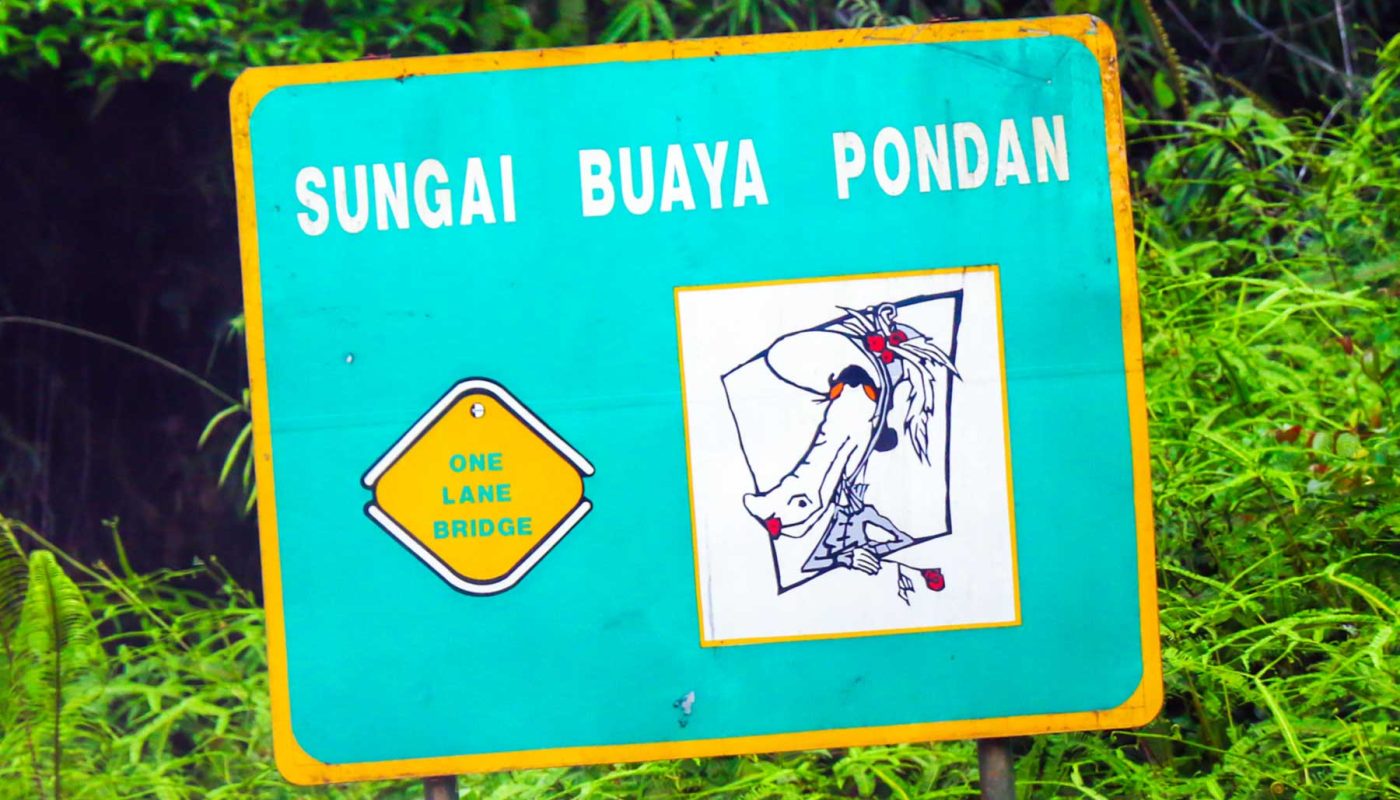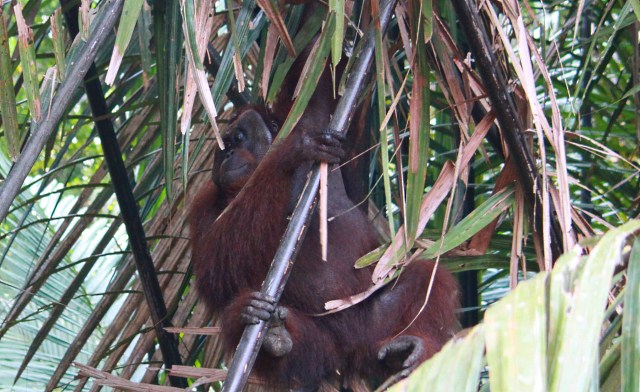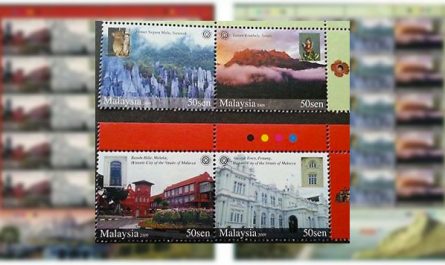We can’t eat our cake, and have it too. At least this is how most environmentalists see logging, which usually means the end of world to wildlife and ecosystem in that forest. Deforestation is really a threat to flora and fauna of Borneo. However, we can’t totally ban logging, like we can’t simply stop fishing for the purpose of conservation. Though Sabah government phased out logging in 2007, lumbering is still an important economy activity. Even USA, Canada and New Zealand export log.
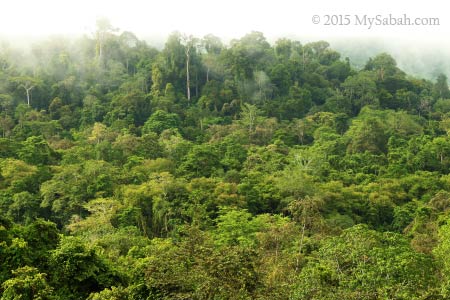
Pic: misty logged forest in Deramakot
What if, we can harvest the timber in a sustainable manner that minimize the impact to our environment? Deramakot, one of the Sabah forest is able to achieve that through Reduced Impact Logging (RIL). This is a great news because 70% of Sabah forest is commercial forest that allows logging.
Nevertheless, many conservation solutions only sound good on paper, so it’s better we see the reality with our own eyes, and that’s my goal to visit Deramakot Forest Reserve organized by Aseh Tours.
Deramakot Forest Reserve
Deramakot is a 55,507-hectare (equivalent to 66,000 soccer fields or 555 Sq. Km) mixed dipterocarp forest in the middle of Sabah and north of upper Kinabatangan River. Deramakot is also the first and longest-certified tropical rainforest in the world as a well-managed forest under FSC™ certification since 1997 (Forest Stewardship Council).
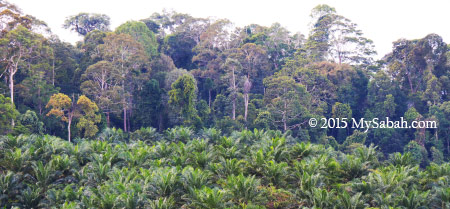
Pic: oil palm plantation at the edge of forest reserve
To reach Deramakot, we drove 237 Km from Kota Kinabalu City (190 Km if from Sandakan City) on paved and gravel roads. After we entered the final 70 km of bumpy gravel road, we saw oil palm plantation and secondary forest along the way. We also passed by some tree nurseries, logging camps and forest replanting zones.
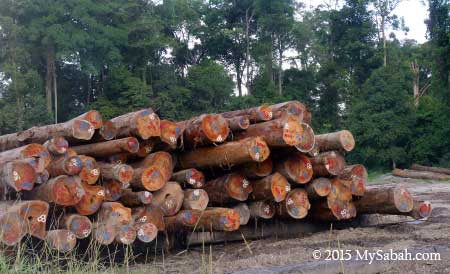
We saw pile of logs from Deramakot ready for public auction to international and local buyers. Each log is marked with ID that can trace its exact location where it was harvested. These logs from Deramakot can generate an annual income of about US$4 millions for Sabah. Some buyers such as IKEA do offer premium prices (15% to 20% more) for certified logs as compared to uncertified logs.
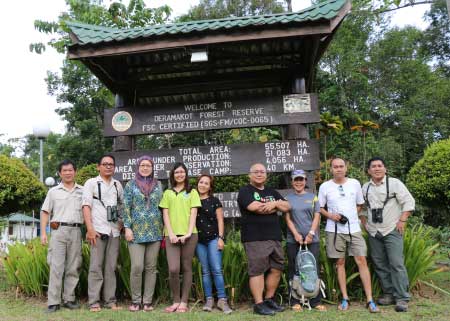
Pic: group photo at entrance to Deramakot Forest. We saw two Black Hornbill there.
Visitors are required to get the permit from Sabah Forestry Department to enter Deramakot. They welcome tourists who are accompanied by experienced tour guide. Strictly no walk-in visitor. We drove through four security gates which guards the forests (i.e. Ulu Sapa Payau, Tangkulap and Deramakot) of Yayasan Sabah and Sabah Forestry Department.
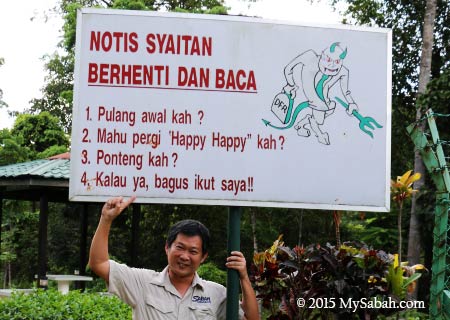
Pic: a funny signboard for forestry staffs, which says (translated), “Satan’s Notice, Stop and Read: 1. Going home early huh? 2. Want to go ‘Happy Happy’? 3. Absent from work? 4. If so, go to Hell!” LOL
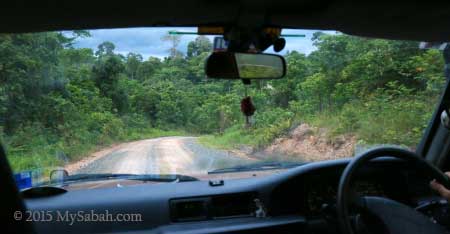
After the last gate, we entered the Deramakot Forest Reserve. We saw no more oil palm and the road condition was much better. It’s possible to access the bumpy and gravel road to Deramakot by sedan or saloon cars during dry season. The road can turn muddy after rain so 4WD is a safer choice.
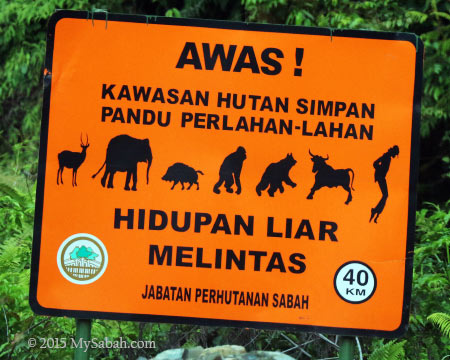
Pic: Warning about wildlife crossing. Note Michael Jackson at the right. LOL
We would run into heavy truck or wildlife in forest road, so we moved at a slow speed of below 40 KM/H. While driving, our tour guide was also keeping an eyes on the forest for wildlife and birds. We saw Barking Deer (Kijang) and long-tailed macaques on the way.
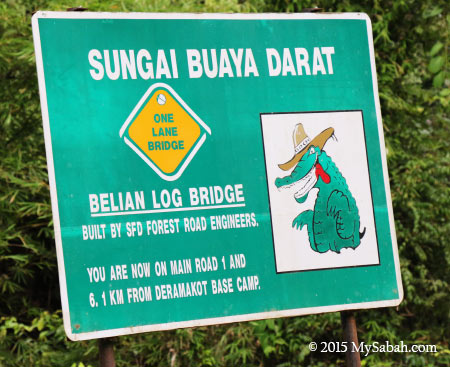
Pic: a funny signboard of “Playboy River” (Sungai Buaya Darat), more photos here. This river does have crocodile.
Night Safari
We were losing daylight but Deramakot base camp was still hour away, so we just slow down, turned on the spotlight of 4WD and did a dusk drive along the way. Most animals here are nocturnal and we spotted common palm civet and two leopard cats. I also saw Badger and Sambar Deers in next day.
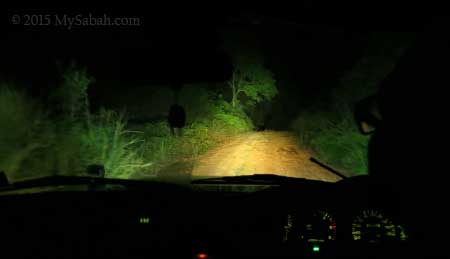
In fact, Deramakot is one of the few places in Borneo where all 5 Bornean cat species are found (namely, Sunda Clouded Leopard, Bornean Bay Cat, Marbled Cat, Flat-headed Cat and Leopard Cat). Leopard Cat is almost a guaranteed sighting, but other 4 cats are in very low density. Clouded Leopard and Bay Cat are endemic to Borneo and highly secretive, but NHK filming crew managed to capture the former cat.
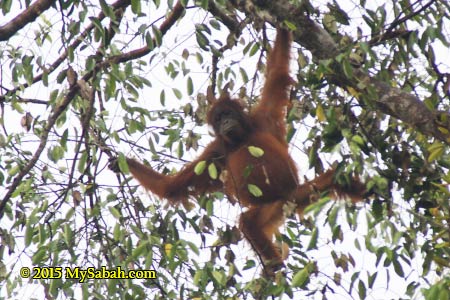
You have 50 to 60% chance of seeing orangutan in the wild at Deramakot. About 792 orangutans dwell in this forest (statistics 1999). Too bad I didn’t see any, but their presence is evidenced by their nests left on the trees.
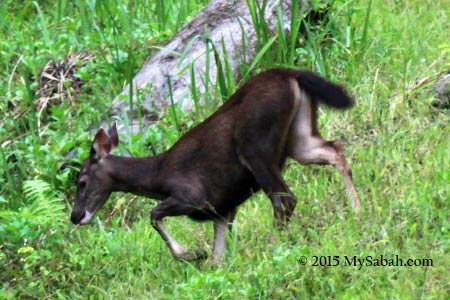
Pic: female Sambar deer
Other potential sighting of wildlife in Deramakot includes Pygmy Elephants, Banteng (Tembadau), Sun Bear, Binturong, Flying Lemur, Gibbon, Reticulated Python, Porcupine, Pangolin and Wild Boar. Anyway, this is not a zoo and the animals here are quite elusive and not used to human presence, so you will need some luck.
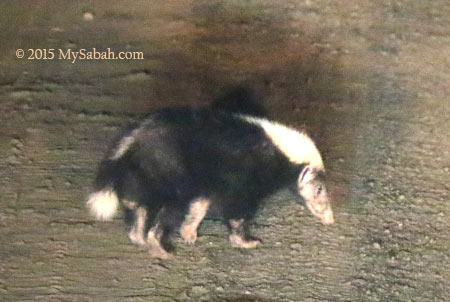
In 2010, the world?s most endangered otter species hairy-nosed otter (Lutra sumatrana) was “rediscovered” in Deramakot when everyone thought it had extincted. To me, it’s quite surprising that so many rare wildlife can be found in a logged forest. Deramakot is a relatively new nature destination, we would uncover more gems when more people explore this forest.
Deramakot Lodge
We arrived Deramakot around 7:30pm and check-in to Deramakot Lodge. Please note this is not a hotel so there is no hotel staff welcomes you with a phony smile. We just collected the key from forestry staff and we were on our own. Though the accommodation is basic and not tourist-oriented, it is clean and comfortable.
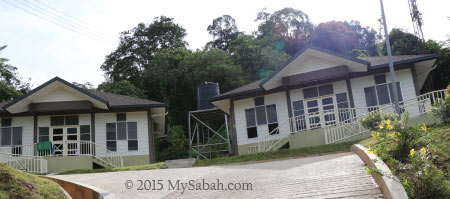
Pic: This is the chalet where we spent two nights. Each chalet has 3 rooms (2 units of Double bed room and 1 unit of Queen bed room) and a living room (no TV though). They even have ramp for wheel chair. There is an old resthouse with 3 bedrooms (2 units of Double bed room and 1 unit of Triple bed room) but it would be reconstructed.
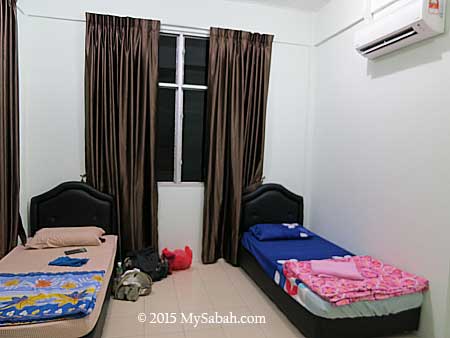
Pic: One of the room in chalet, with fan and air-conditioning. Every room has an attached bathroom with hot shower. Blanket, pillow, towel, soap and shampoo are provided. Electricity is available 24×7. Wifi is available during weekdays and there is no phone network coverage. There are another two chalets nearby, which have dormitory bedrooms with bunk beds, you can see their photos in my photo album. The lodges can host a total of 31 people at a time.
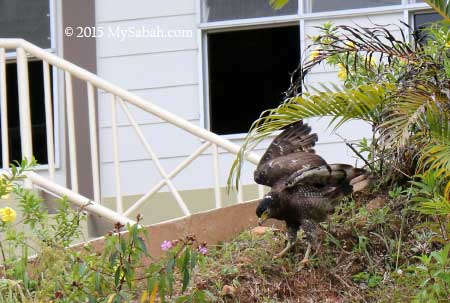
The chalet is near the forest edge so you would find wildlife foraging around. I saw long-tailed macaques, crested serpent eagle and flying lizard near my chalet.
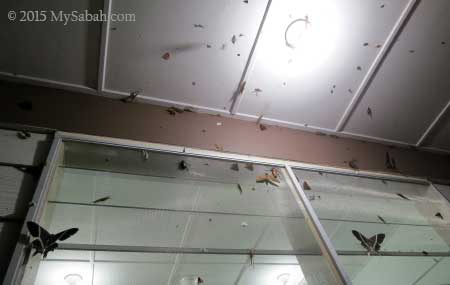
At night the light at our balcony became a magnet for hundred of moth, beetles, katydid, cicada, etc. You can look at this photo and count how many they are. They are just everywhere. I had to close the door fast before they flied into the house. The bug also attracted a Brown Wood Owl looking for easy meals near our building.
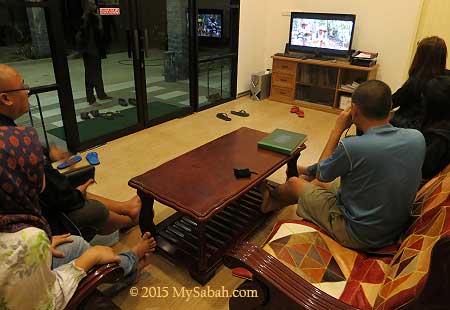
Pic: watching video about Reduced Impact Logging
There is no canteen, restaurant, shop and room service in the base camp, so you have to prepare your own food, or you can request the forestry staffs to provide food catering (for a fee) like what we did. We had rice, vegetables, chicken, fish and fruit for every meal (quite delicious). We were quite well-fed actually. After dinner, we were invited by Sabah Forestry Department to watch a video about Reduced Impact Logging in Deramakot.
Reduced Impact Logging (RIL)
Now you may wonder why wildlife can do so well in a logged forest. Reduced Impact Logging (RIL) is the answer, as you might have expected. RIL is a very big topic and someone can write a book to talk about it. I’ll only scratch the surface here. To learn more, you can visit website of Deramakot.
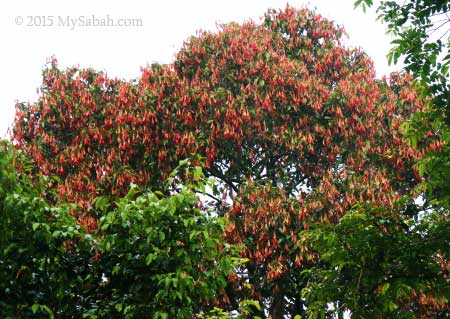
Conventional Logging is destructive. Basically, the loggers just bulldoze everything to make way, cut down all valuable timbers and leave a mess behind. This unsustainable method hurts the forest so much that it needs 50 to 80 years to regenerate.
In contrast, RIL employs different harvesting strategies that leave the forest mostly intact, to a level that it only takes 25 years to regenerate. Moreover, logged forest of RIL will be left to recover for 40 years before next harvest (felling cycle).
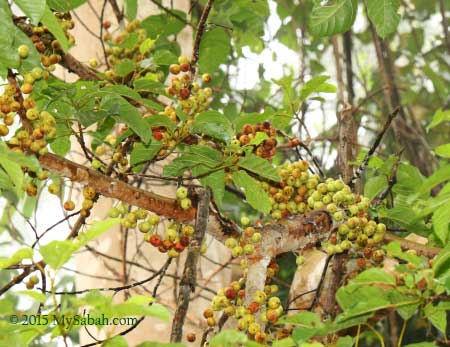
Pic: fig fruit is an important food source for orangutan and hornbill
To be more friendly to wildlife habitat and ecology of a rainforest, RIL doesn’t cut fruit trees and small trees (less than 60cm in diameter). It also leaves buffer zone for riparian, steep slope, watershed, and other elements that keep the forest healthy and stable. Though the logged forest is degraded to some degrees, it still remains very livable for local flora and fauna.
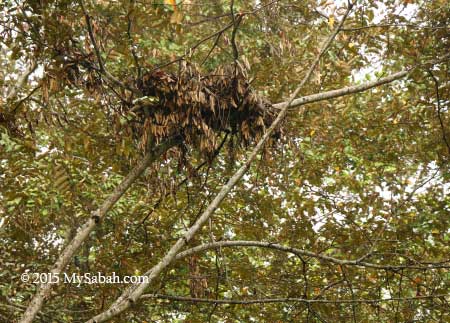
Pic: orangutan nest on the tree
RIL also reduces the soil damage by 50%. This is crucial because top soil contains Mycorrhizal fungi community that acts as a root extension for indigenous trees to absorb water and nutrients more efficiently. This measure promotes faster forest restoration and cut the cost of rehabilitation from RM5,000 to RM300 per hectare! Besides, silviculture and tree replanting are carried out to keep the forest in good shape. Auditors of FSC will come to check the forest regularly for re-certification (or revoke).
Dawn Drive & Morning Walk
Morning offers the best photography opportunity to capture beautiful view of misty rainforest. We waked up very early and started our exploration by 4WD around 5am. Deramakot Forest is lively during dawn. We heard the loud call of Bornean Gibbons and bird chirping everywhere. Unlike the muggy city, the air here is refreshing and cooling.
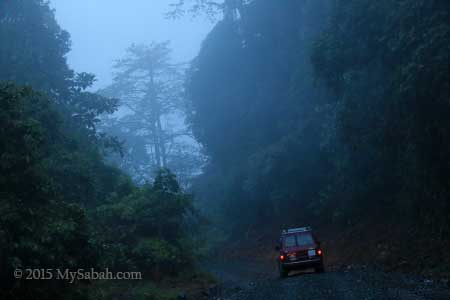
I didn’t see any large area of exposed soil (a bad characteristic of traditional logging practices). Deramakot Forest Reserve is divided into 135 compartments for sustainable forest management and lumbering. About 75% of Deramakot must remain undisturbed or closed to forest management activities at any given time.
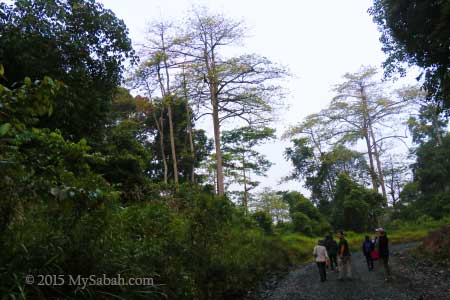
To enjoy the fresh and clean air, we decided to get out of our car and took a leisure morning walk. According to biophilia hypothesis, humans have a psychological need for greenery and contact with nature is a basic human need. That explains why a walk in the wood is always a pleasant experience.
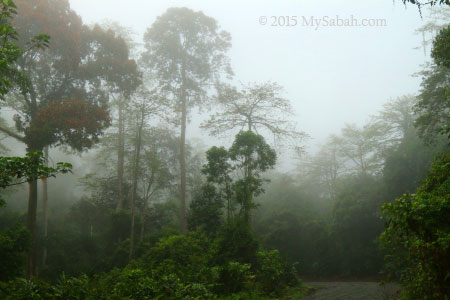
Deramakot is an excellent bird watching site. We spotted or heard Rhinocerous hornbill, Asian Paradise Flycatcher (twice!), Buff-necked woodpecker, whiskered tree swift, Black-headed bulbul, Blue-eared kingfisher, Oriental dwarf kingfisher, Crested Fireback, Changeable Hawk-eagle, Racket-tailed Drongo, Yellow and Black Broadbill, White-crowned shama, etc. Black & Crimson Pitta, Great argus pheasant, Bornean Bristlehead and 8 species of hornbill also live here. Our guide says the “feature” birds here are Helmeted Hornbill and Wreathed Hornbill.
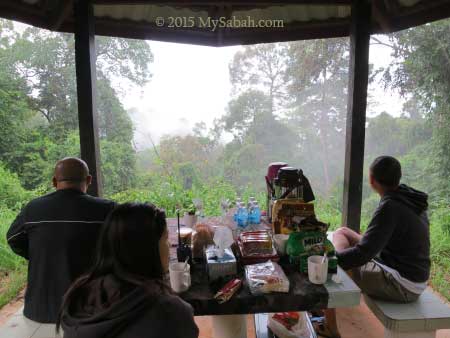
Then we picnic under a shelter. Deramakot isn’t a destination for mass tourism and we were the only tourists there. I really enjoyed the secluded moment.
Jungle Trekking
Near the basecamp there are two jungle trails for you to see the forest logged by both Conventional & RIL methods. Each trail is about 1 to 2 Km and takes about 30 minutes to 1 hour of hiking, they are quite well-maintained and not challenging (but watch out for a few slippery and steeper areas).
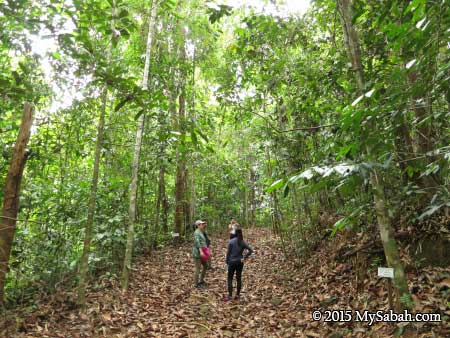
During our visit, it was dry season so the forest floor was covered by layer of dry foliages. Only a few tiny leeches were around so I didn’t even bother to put on my anti-leech socks. Not many wildlife was found though. I heard the flapping of a few hornbills above the canopy.
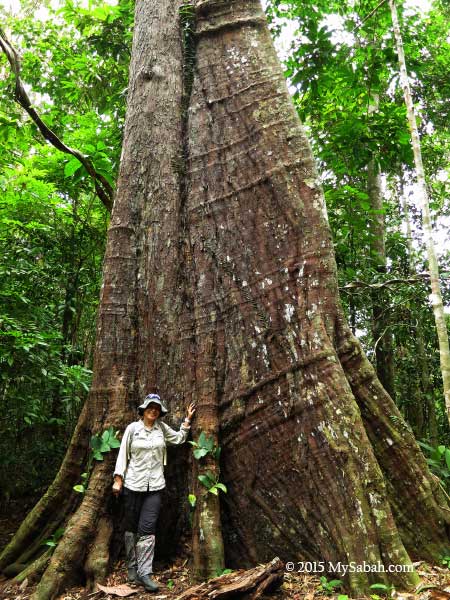
The forest seemed like a young secondary forest in good quality. Though they were logged before, there are still many standing tall trees that provide plenty of shade. Sivilculture is also in place to remove other competing plants such as climbing vines and scrubs that hinder the growth of timbers.
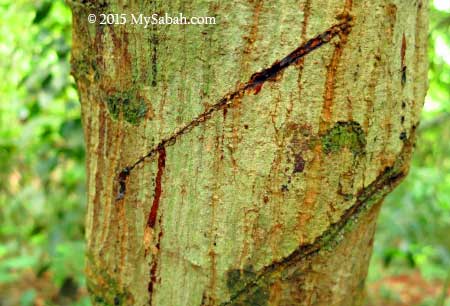
Pic: Darah-Darah (Myristicaceae), a tree that “bleeds”
Along the nature trail are rich variety of big and small trees labeled with interesting local names like Ghost Durian (Durio grandiflorusurat), Worm Eye Smooth Leaf (Parashorea malaanonan), Thin-skinned (Memecylon edule), Bitter-Bitter (Eurycoma longifolia). I hope they can use info-rich signages that tell visitors the special use / story of each plant. For example, the sap of Paliu tree (Antiaris toxicaria) is used in making poison dart.
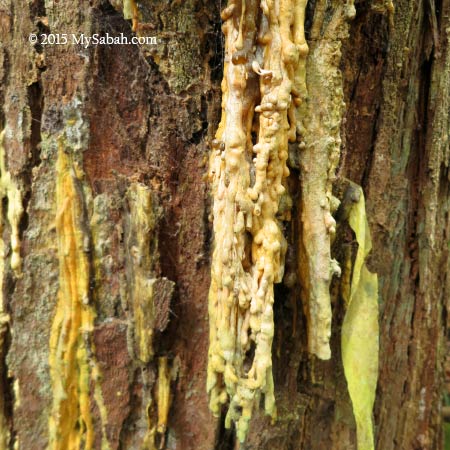
Pic: When burnt, this resin smells like the incense in Buddhist temple
I’m not a plant expert and only can tell you that there are many species of famous timbers such as Seraya (Shorea), Kapur (Dryobalanops) and Keruing (Dipterocarpus) in Deramakot.
Camera Traps
For some fun, we collected four camera traps that were deployed in different wildlife hotspots in Deramakot forest a few months ago. Normally the camera trap is strapped on tree trunk one Meter above ground and the batteries can last about 3 to 6 months.
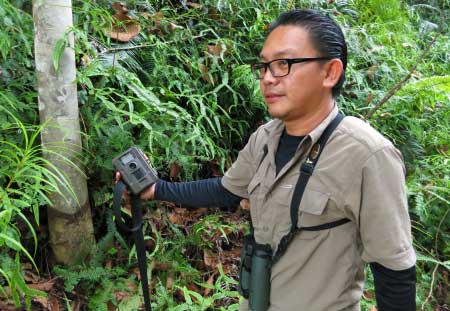
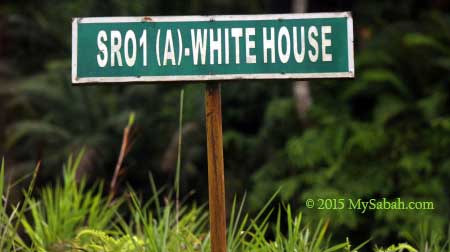
Two of the camera traps were near to the road to “Whitehouse”, which is a building painted in white and has nothing to do with US President, haha.
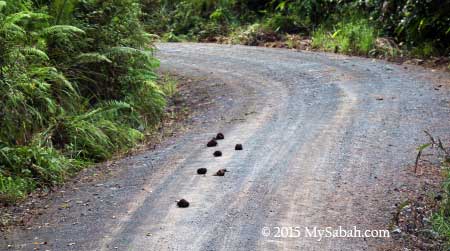
The gravel road to Whitehouse is narrow and bumpy. We saw a lot of elephant dungs on the road. Whenever our car turned at a tight corner, my heart would beat faster, imagined that our car would bump into an elephant face to face. That would be a scary but exciting moment, but we saw more dungs instead.
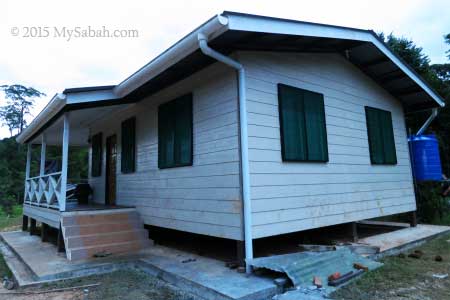
After driving 27 Km, we arrived Whitehouse and found the place was raid by elephants. The Whitehouse was attacked! Don’t worry, Obama wasn’t there.
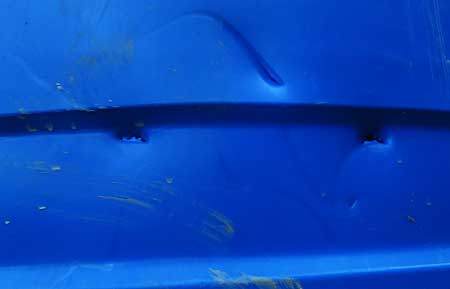
Pic: the water tank was punctured by elephant tusk. I have no idea why they were so mad. Probably these elephants are the members of Republican Party in US.
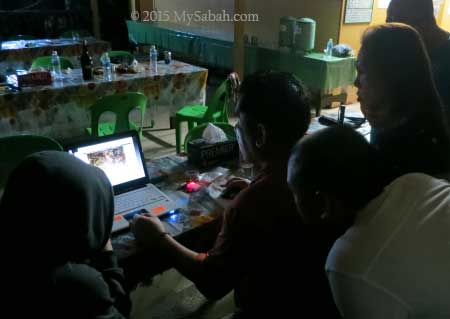
Unfortunately, one of the camera traps was broken and another one was out of battery. We downloaded the photos from other camera and had fun looking at those cheeky selfie by monkey, palm civet and wild boar.
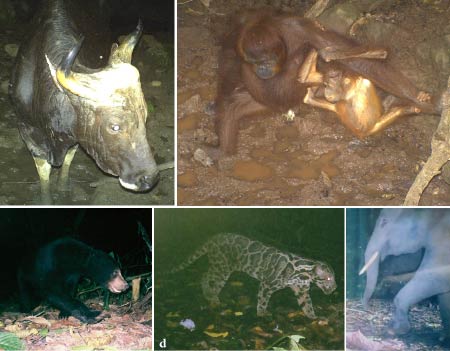
Pic: wildlife captured on camera trap
Camera trap is a useful tool to monitor the number and types of wildlife. The shot is in color if taken during daytime, black & white if shot by infrared at night. The most commonly captured animals are mouse deer, barking deer, macaque and wild boar.
Going to Deramakot
Deramakot is a unique destination because it’s an eye-opening experience for tourists to witness the abundance of wildlife in a logged but well-managed forest. The positive news is the model of Deramakot will be implemented in 81% of other commercial forest (a total area of 1.8 million ha). Uncontrolled and unsustainable timber exploitation will become history.
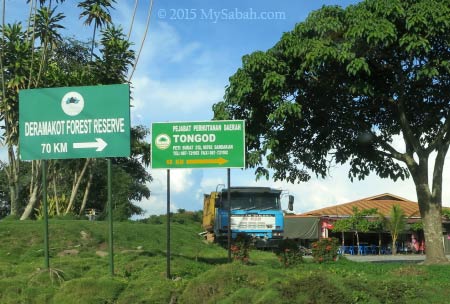
Pic: Junction to Deramakot (another 70 KM on gravel road)
To enter Deramakot Forest, you need to write to Director of Sabah Forestry Department to apply for entry permit for yourself and your vehicle (fees apply). However, for safety concern, it’s quite likely that they will reject your application if you visit Deramakot without guiding by travel agent or tour guide. I think the last thing they want to hear is some clueless tourists being gored by a wild elephant or lose in jungle.
Therefore, I advise you to book a tour package to Deramakot through Aseh Tours. They will arrange everything for you, from permit, 4WD transport, food, accommodation to guide services. The fee is between RM2,000 to RM3,000 per person (for a 3 or 4 day trip).
Below are the contact of Sabah Forestry Department:
Sabah Forestry Department (HQ)
Address: Locked Bag 68, 90009, Sandakan, Sabah, Malaysia.
Tel: +60 89-242500
Fax: +60 89-671303 / 672579 / 669170
Website: www.forest.sabah.gov.my
Facebook: SabahForestryDepartment
Deramakot District Forestry Office
Tel: +60 89-278801
Website: www.deramakot.sabah.gov.my
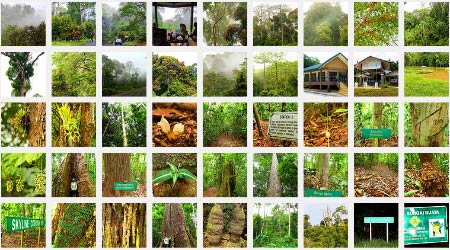
For more photos of Deramakot, please check out my photo album.
Photos taken in Tongod, Sabah, Malaysia Borneo
